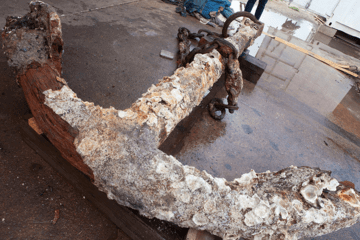Image credit: Texas A&M University
In 1792, George Vancouver, a great explorer of his time, is sailing in the waters of what is now Vancouver Island (at Puget Sound to be precise), when his service ship, the HMS Chatham, lost her anchor. The HMS Chatham was a service ship that accompanied the HMS Discovery on Vancouver’s four-and-a-half-year exploration around the world.
An anchor, suspected to be that anchor, has been recently recovered and is now in the expert hands of Texas A&M’s Center for Maritime Archaeology and Conversation, the same organization that was responsible for the recovery of Cavelier de La Salle’s shipwreck discussed in a previous post, La Salle’s Shipwreck.
It will take 18 months to meticulously clean the anchor and confirm if it is indeed the anchor of the British HMS Chatham.
The LiveScience article, Long-Lost Anchor May Soon Give up Its Secrets, explains the fascinating process they will use to remove the rust and the crusty coating of sea shelves from the surface in order to reveal the original iron surface and its possible markings, critical to identify the anchor. In short, the setup is basically an electrolytic cell, with positively and negatively charged electrodes, and the current flowing into the anchor will remove the salt from the iron. The conservators will also use tools to remove the sea shelves each time the tank water needs to be changed (4 or 5 times over the 18-month duration of the cleaning).
For more information on Vancouver Island’s history, you can read the fascinating book The Land of Heart’s Delight.

